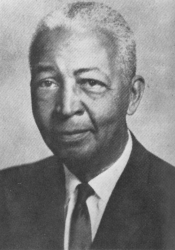<Back to Index>
- Chemist Lloyd Augustus Hall, 1894
- Sculptor Jacques François Joseph Saly, 1717
- Member of the French Resistance Jean Moulin, 1899


Lloyd Augustus Hall (June 20, 1894 - January 2, 1971) was an African American chemist who contributed to the science of food preservation. By the end of his career, Hall had amassed 59 United States patents, and a number of his inventions were also patented in other countries.
Hall was born in Elgin, Illinois on June 20, 1894. Hall's grandmother came to Illinois via the "Underground Railroad" at the age of sixteen. His grandfather came to Chicago in 1837 and was one of the founders of the Quinn Chapel A.M.E. Church. He later became the church's first pastor in 1841. Hall’s parents, Augustus and Isabel, were both high school graduates. Although Lloyd was born in Elgin, he moved to Aura IL. and was raised there by his parents. He later graduated in 1912 from East Side High School in Aurora. After graduating school he went on to study pharmaceutical chemistry at Northwestern University, earning a B.S. and his master's. It was at Northwestern that Hall met Carroll L. Griffith, who with his father, Enoch L. Griffith, would found Griffith Laboratories. The Griffiths went on to hire Hall as their chief chemist.
After leaving university Hall was hired by the Western Electric Company but as the interview had been conducted over the telephone they did not know that he was black and refused to hire him. Hall then went to work as a chemist for the Department of Health in Chicago followed by a job as chief chemist with the John Morrell Company.
During World War I Hall served with the United States Ordnance Department where he was promoted to Chief Inspector of Powder and Explosives.
Following
the war Hall married Myrrhene Newsome and they later moved to Chicago
so he could work for the Boyer Chemical Laboratory, again as a chief
chemist. Following this, Hall became President and Chemical director
for Chemical Products Corporation's consulting laboratory. Finally in
1925 Hall was offered a position with Griffith Laboratories where he
was to remain for 34 years. Hall devoted much of his efforts to the technologies behind curing meat, particularly to improving a curing salt marketed by Griffith Laboratories known as flash-drying. This product originated with German chemist Karl Max Seifert, developer of a process whereby solutions of sodium chlorine and
one or more secondary salts were sprayed onto hot metal and rapidly
dried, producing crystals of the secondary salts encased inside a shell
of sodium chloride. Seifert patented the process in 1934 and sold the
rights to Griffith Laboratories. The adaptation of Seifert's process
specifically for meat curing was then patented by company owner Enoch
L. Griffith, who proposed nitrates and nitrites, well-known curing agents, as the secondary salts. Lloyd
Hall is often falsely credited with the original invention of Seifert's
process. However, Hall took a leading role in developing the patent
after it was sold to Griffith Laboratories, adding hygroscopic agents such as corn sugar and glycerine
to inhibit caking of the powder. Most of his patents in meat curing
dealt with either preventing caking of the curing composition, or
remedying undesired effects caused by the anticaking agents. Hall also investigated the role of spices in food preservation. It was common knowledge that certain seasonings had antimicrobial properties, but Hall and co-worker Carroll L. Griffith found that some spices carried many bacteria, as well as yeast and mold spores. To counter these problems, they patented in 1938 a means to sterilize spices through exposure to ethylene oxide gas, a fumigant. This method was all but abandoned upon the discovery that ethylene oxide was a toxic carcinogen. Hall and Griffith later promoted the use of ethylene oxide for the sterilization of medical equipment, helping to advance an idea that had been around for several years. Hall also invented new uses of antioxidants to prevent food spoilage, especially the onset of rancidity in fats and oils. Aware that unprocessed vegetable oils frequently contained natural antioxidants such as lecithin that
slowed their spoilage, he developed means of combining these compounds
with salts and other materials so that they could be readily introduced
to other foods. After retiring from Griffith in 1959, Hall consulted for the Food and Agriculture Organization of the United Nations. From 1962 to 1964, he sat on the American Food for Peace Council. He died in 1971 in Pasadena, California. He was awarded several honors during his lifetime, including honorary degrees from Virginia State University, Howard University, and the Tuskegee Institute and in 2004 he was inducted into the National Inventors Hall of Fame for his work. He was a member of Alpha Phi Alpha, the first intercollegiate Greek-letter fraternity established for African Americans.